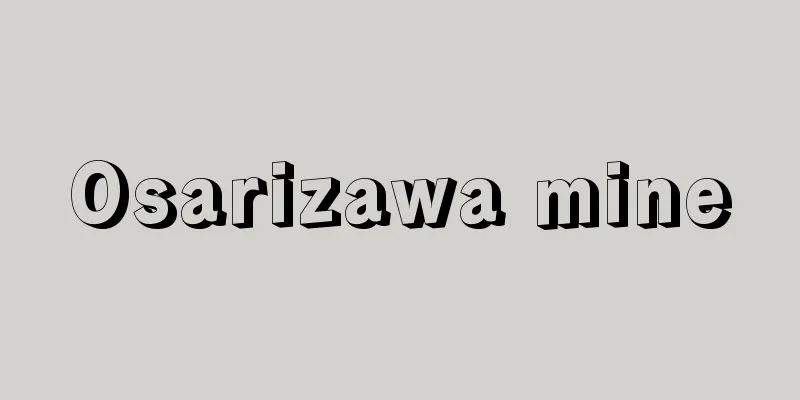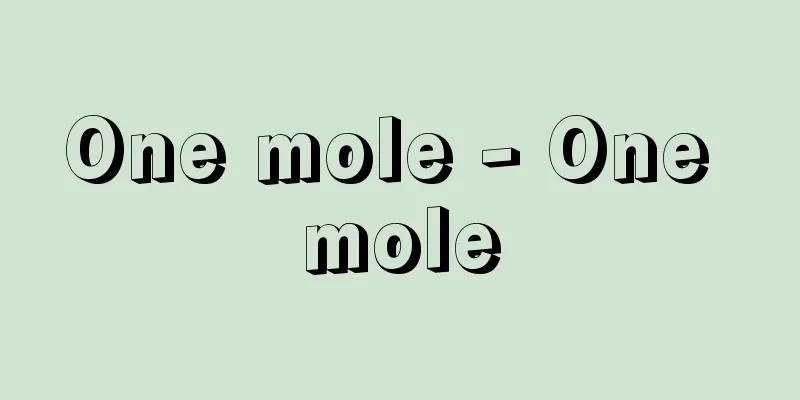Osarizawa mine

|
This mine is located in Kazuno City, northeastern Akita Prefecture. During the Edo period, it was the largest copper mine of the Nanbu clan of Morioka Domain. According to oral tradition, it was discovered during the Wadou period (708-715), but this is not certain. During the Keicho period (1596-1615), gold was mined in Shirane and Makiyama, but this soon declined and copper was selected instead. Copper is said to have been first discovered in 1666 (Kanbun 6). After that, it was mined in Tagori, Shikazawa, Akazawa, and other areas in the Osarizawa region. At first, it was mined by Morioka merchants who were contracted by the domain, but from 1765 (Meiwa 2) it was directly managed by the domain until the Meiji period. The amount of copper produced in 1771 was about 750,000 jin (about 450 tons). The crude copper was transported to Noheji Port, and sent to Osaka via the westbound and eastbound routes. In the Meiji era, it was run by Murai Shigebei, but it was confiscated by the Ministry of Finance as payment for the foreign debts of the former Morioka Domain, and was sold to Okada Heizo. Since 1889 (Meiji 22), it has been managed by the Iwasaki family (Mitsubishi Limited Partnership Company in 1893). In 1972 (Showa 47), management was transferred to the Osarizawa Mine, and it closed in 1978 due to the depletion of ore reserves. It has since been open to the public as a tourist facility. The mine stretches 4 km from north to south and 2.5 km from east to west, and its geology dates to the middle of the Holocene (Alluvial Epoch), with the most developed veins in the hard mudstone known as the Shishizawa Formation. In addition to copper, it produced gold, lead, zinc, iron sulfide, manganese, and other minerals. In November 1936, a dam in the refinery's sulfide mud reservoir collapsed, burying miners' tenements downstream and causing a major disaster that killed 362 people. It then collapsed again in December, killing 12 more. [Reijiro Miyazaki] This theme park uses the remains of the Osarizawa Mine, which closed in 1978 (Showa 53). You can visit the mining site from that time, and inside the mine, the mining scene from the Edo period to modern times is recreated and exhibited. Kazuno City, Akita Prefecture © Akita Prefecture Tourism Division "> Historic Osarizawa Mine Source: Shogakukan Encyclopedia Nipponica About Encyclopedia Nipponica Information | Legend |
|
秋田県北東部、鹿角市(かづのし)にある鉱山。江戸時代には盛岡藩南部(なんぶ)氏最大の銅山であった。口碑によると、和銅(わどう)年間(708~715)の発見と伝えられるが確かではない。慶長(けいちょう)年間(1596~1615)に白根(しらね)、槇山(まきやま)などで金が採掘されたが、まもなく衰え銅へ移った。銅が最初に発見されたのは1666年(寛文6)と伝えられる。その後、尾去沢地域の田郡(たごおり)、鹿沢(しかさわ)、赤沢などで稼行した。最初は藩から請け負った盛岡商人の手によって採掘されたが、1765年(明和2)以来明治に至るまで藩の直営となった。1771年の産銅額は約75万斤(約450トン)という。粗銅は野辺地港(のへじこう)へ運ばれ、西廻(まわ)り、東廻りで大坂へ回送された。明治になって村井茂兵衛が経営したが、旧盛岡藩の外国負債の代償として大蔵省が没収、岡田平蔵が払下げを受け、1889年(明治22)以来岩崎家(1893年三菱合資会社(みつびしごうしがいしゃ))の経営になった。1972年(昭和47)尾去沢鉱山に経営移管し、1978年鉱量の枯渇によって閉山した。その後は観光施設として公開されている。 鉱山は南北4キロメートル、東西2.5キロメートルに及び、地質は完新世(沖積世)中期で、獅子沢(ししざわ)層とよばれる硬質泥岩中に鉱脈がもっとも発達していた。銅のほか、金、鉛、亜鉛、硫化鉄、マンガンなどを産した。 なお、1936年11月、精錬所の硫化泥沈殿貯水池のダムが決壊して下流の坑夫長屋が埋没し、死者362人を出す大惨事を起こし、さらに12月にも再度決壊し12人の死者を出した。 [宮崎禮次郎] 1978年(昭和53)に閉山した尾去沢鉱山跡を利用したテーマパーク。当時の採掘現場を見学することができ、坑内には江戸時代から近代に至るまでの採掘のようすなどが再現、展示されている。秋田県鹿角市©秋田県観光課"> 史跡尾去沢鉱山 出典 小学館 日本大百科全書(ニッポニカ)日本大百科全書(ニッポニカ)について 情報 | 凡例 |
Recommend
Runabout
…Most motorboats are used as pleasure boats for r...
Hernia belt - truss
Also called a hernia band. A type of band worn for...
Pleura - Pleura
A serous membrane that covers the surface of the ...
Onespot snapper
This marine fish belongs to the order Perciformes...
Ryokufukai
A faction in the House of Councillors. It was for...
Pheromone - pheromone (English spelling)
A general term for substances released by an indi...
Fundamental Ontology - Fundamental Ontology
The question of existence in general must be prece...
Dezfūl (English spelling)
A city in Khuzestan Province in southwestern Iran....
Copepods - Eastern Copepods
A general term for small animals belonging to the...
Shinto - Shinto
Overview Japanese ethnic beliefs. These are the e...
《Andiana》 - Andiana
After the Revolution, she lived a peaceful life i...
Mirror surface
...The inversion shown in Figure 11 is the invers...
Rosen
A haiku poet of the mid-Edo period. Naito clan. B...
Song
...a literary term that describes a style of stor...
Boron nitride (boron nitride)
Chemical formula: BN. It is produced by mixing sod...





![Shiroishi [town] - Shiroishi](/upload/images/67cbe6ca8cfc2.webp)



